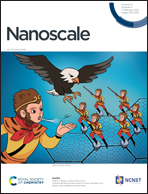Highly sensitive detection of caspase-3 activity based on peptide-modified organic electrochemical transistor biosensors†
Abstract
Caspase-3 is an important proteolytic enzyme that cleaves several key substrates in apoptotic processes, resulting in DNA fragmentation, the degradation of nuclear proteins, and the formation of apoptotic bodies. However, it is challenging to detect caspase-3 due to its low expression levels in cells. In this work, organic electrochemical transistors (OECTs) are used in the detection of caspase-3 for the first time. A self-assembled monolayer of the peptide is bonded to the Au gate electrode (GE) of an OECT via gold–sulphur bonds. It is found that the transfer curve of the transistor shifts to a lower gate voltage due to the modulation of the surface potential of the GE by the peptides. Then, the device is used in the detection of caspase-3 in aqueous solutions and shows a detection limit of 0.1 pM. Due to its high sensitivity, the device can detect caspase-3 in induced apoptotic HeLa cells. The system is low-cost, conveniently used and applicable for biological and medical monitoring where caspase-3 detection and quantification are required.



 Please wait while we load your content...
Please wait while we load your content...